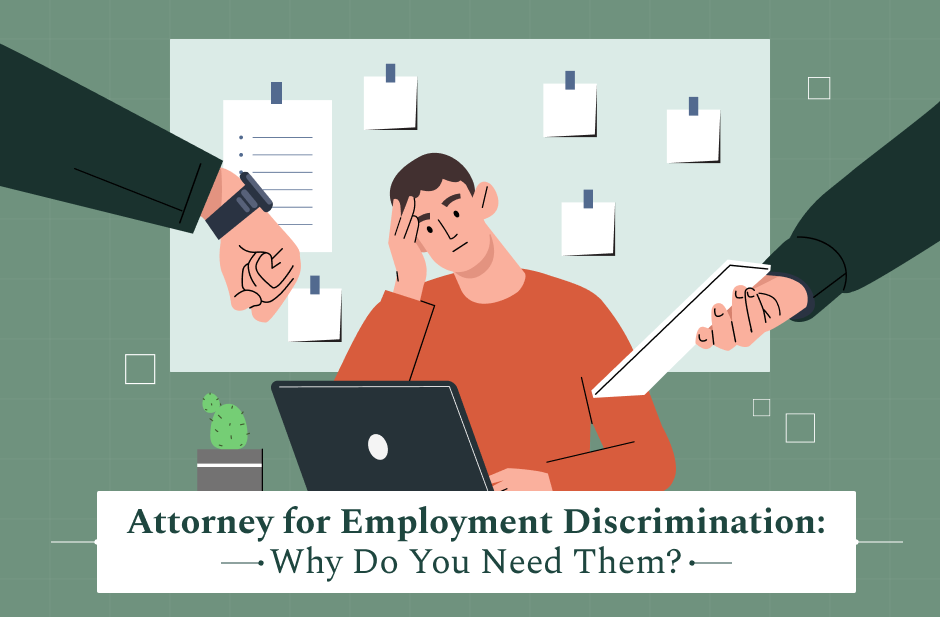Have you ever been unfairly treated or mistreated at work? Maybe you’ve witnessed someone go through a similar experience. Unfortunately, workplace discrimination is an all-too-common issue that can affect anyone, regardless of their background, designation, or qualifications. Workplace discrimination laws are regulations put into practice so as to protect employees from discrimination, ensuring equal opportunities and fair treatment in the workplace, irrespective of age, race, gender, disability, and more criteria.
These laws apply to you, whether you’re an employee or an employer. it’s crucial to understand your rights and responsibilities in order to foster a respectful and inclusive work environment.
So, without further adieu, let us get some answers to your most frequently asked questions about Workplace Discrimination Laws.
Workplace Discrimination Laws And Employment Discrimination Laws

To understand workplace discrimination laws, we need to understand the broader category of employment discrimination. what they mean, and your rights under them, you must first understand what the terms “workplace”, “employment,” and “discrimination” mean.
What Is A Workplace?

The legal definition of a “workplace” is the “physical or virtual location” where employees carry out their work. It includes all such settings where one is employed, including offices, factories, warehouses, retail stores, and all other places of business.
All areas where the definition applies to fall under the jurisdiction of labor laws, health and safety regulations, and other workplace-related legal protections.
Types Of Workplaces
There are different types of workplaces. They include:
- Physical Workplace
This includes:
- Office Spaces, the traditional ones.
- Industrial and Manufacturing Facilities, like factories and warehouses.
- Retail Establishments, where sales, customer service, and product displays are carried out.
- Educational Institutions, like schools, colleges, and universities, where teachers and staff work.
- Healthcare Facilities like hospitals, clinics, and medical centers where healthcare professionals provide services.
- Construction Sites, like buildings and roads.
- Virtual Workplace
This includes:
- Remote Working spaces like built-in applications and virtual media.
- Other virtual collaboration platforms.
What Laws Are Applicable to These Workplaces?

These laws extend and apply to all workplaces.
- Labor Laws
Laws regarding employment contracts, working hours, wages, overtime pay, and employee rights.
- Health and Safety Regulations
These protect employees from hazards and ensure a safe work environment.
- Employment Standards
These set standards for working conditions, vacation entitlements, and termination procedures.
- Workplace Discrimination Laws
These prohibit unfair treatment based on protected characteristics such as race, gender, age, and disability.
- Privacy Laws
These protect employee privacy in the workplace and the use of personal information and monitoring.
What Are Some Workplace Discrimination Laws On Employee-Employer Dynamics?

Workplace discrimination laws work by promoting inclusivity and maintaining healthy employee-employer dynamics. These are federal and state laws that ensure fair treatment for all employees. A workplace that is void of discrimination has proven to be a happier and more productive one. Here is a quick look at some federal laws that promote a healthy and appropriate employee-employer dynamic.
- Title VII of the Civil Rights Act of 1964 declares all discrimination based on race, color, religion, sex, or national origin, to be illegal.
- The Age Discrimination in Employment Act protects senior employees from being illegally fired due to age.
- Americans with Disabilities Act protects employees with disabilities.
- The Equal Pay Act protects men, women, and others from unfair pay gaps.
These were some of the basic examples of workplace discrimination legislation.
The Definition Of “Employment”
The legal definition of employment is “a formal relationship between an employer and an employee”. This formal relationship is given form through an agreement or contract where the employee agrees to perform duties or services for the employer. In exchange for these duties, they receive payment, benefits, or other forms of compensation.
Employment has to have the following characteristics.
1. An Agreement Between Employer and Employee
There is a mutual understanding between the employer and the employee stating the terms and conditions of the work that the employee will provide within the specific time period. Ideally, this is expressed in writing or implied through conduct. Consent is necessary from both parties.
2. Specification of the Work or Services to be provided to the Employee
Here, the employee in question agrees to provide labor, skills, or services to the employer as part of their job responsibilities.
3. Payment or Compensation to be provided by the Employer
In return for the work performed, the employer provides monetary payment (salary or wages) or other benefits such as health insurance, vacation days, or retirement plans.
4. Agreement of Supervision by Employer
The employer exercises a certain level of control and supervision over the employee’s work, specifying tasks, work hours, and performance expectations.
5. Duration of Employment
Employment may be for a specific duration. This is known as a fixed-term contract. Employment for an indefinite period is known as permanent employment.
The legal definition of employment varies by jurisdiction and may be subject to specific labor laws, regulations, and employment contracts that govern the rights and obligations of both the employer and the employee.
What is Discrimination?
When someone is treated unfairly, differently, or unjustly due to their race, ethnicity, gender, religion, age, disability, or sexual orientation, it is called Discrimination. Discrimination can occur in places of employment, housing facilities, educational institutions, and even public services.
The legal definition of discrimination varies on the jurisdiction you fall in, but most laws prohibit discrimination and promote equality.
What Is Employment Discrimination?

Employment discrimination is the unfair treatment of employees or even applicants based on their characteristics, such as race, color, national origin, sex, religion, disability, age, or genetic information.
It occurs when employers make employment-related decisions, such as hiring, firing, promotions, pay, or job assignments, not based on a person’s qualifications or performance.
What Are The Various Types Of Employment Discrimination?

These are the types of discrimination faced by employees.
a. Racial Discrimination- Treating someone less than others based on their race or ethnicity.
b. Gender Discrimination- Unfair treatment based on a person’s sex or gender identity.
c. Age Discrimination- Treating someone less favorably because of their age, typically affecting older workers.
d. Disability Discrimination- Unfair treatment based on a person’s physical or mental disabilities.
e. Religious Discrimination- Treating someone differently due to their religious beliefs or practices.
Now, in this article, we will also explore the most commonly asked questions about workplace discrimination and workplace discrimination laws. This will help you get a more practical view of employment discrimination around the world.
What Are Some Workplace Discrimination Examples?
Here are some examples of workplace discrimination along with the workplace discrimination laws applicable against them.
Example 1
Shardah (She/Her), a highly qualified candidate, applies for a senior management position at the company she works in. Moreover, despite her qualifications and work experience, the promotion is granted in favor of a less qualified male colleague.
What Federal Law Protects Her?
The Equal Pay Act of 1963 and Title VII of the Civil Rights Act of 1964 offers all citizens of the United States protection against gender discrimination in the workplace.
These laws make it illegal for employers to make employment decisions, such as hiring, promotions, and wages, based on the gender of the individual.
The victim has the right to file a complaint with the Equal Employment Opportunity Commission (EEOC). Moreover, they can also choose to press legal charges against their company for gender discrimination.
Example 2
Robert (They/Them), who is in their late 50s, has been working at a tech giant for many years. The company suddenly laid them off; shortly after, several younger employees were hired in their place with less experience.
What Federal Law Protects Them?
The Age Discrimination in Employment Act of 1967 (ADEA) protects all employees who are 40 years or older from age-based discrimination in the workplace. Therefore, employers cannot make employment decisions, including hiring, firing, layoffs, promotions, or benefits, based on an individual’s age.
Robert can file a complaint with the EEOC and sue the company for age discrimination.
Example 3
James (He/They) has a physical disability and has been working at a company for 8 years. Despite his carrying out the daily duties of his job effectively, the company gives him no reasonable accommodations (like a wheelchair). Therefore, this makes it difficult for James to carry out his work.
What Federal Law Protects Him?
The Americans with Disabilities Act (ADA), 1990, protects individuals with disabilities from any sort of discrimination in the workplace. Therefore, employers should provide reasonable accommodations to qualified individuals with disabilities.
Therefore, James can file a complaint with the EEOC and sue for disability discrimination.
FAQ 2: What Are Some Workplace Discrimination Cases?
Here are workplace discrimination rulings along with the applicable laws.
Lilly Ledbetter v. Goodyear Tire & Rubber Co.
Lilly Ledbetter was being paid significantly less than her male counterparts in a similar position at Goodyear Tire & Rubber Co. Therefore, she filed a complaint on gender-based pay discrimination.
Applicable Workplace Discrimination Laws
Equal Pay Act of 1963 mandates equal pay for equal work regardless of gender.
Young v. UPS
Peggy Young, a UPS driver, who was pregnant at the time, requested light-duty work due to pregnancy-related issues. Her request was denied leading to her getting fired. Therefore, Peggy filed a lawsuit due to pregnancy discrimination.
Applicable Workplace Discrimination Laws
Pregnancy Discrimination Act (PDA) of 1978 and Title VII of the Civil Rights Act prohibits discrimination based on pregnancy, childbirth, or other medical conditions.
Obergefell v. Hodges
Jim Obergefell, a gay man, was denied recognition of his marriage on his husband’s death certificate. Additionally, he filed a lawsuit challenging the refusal.
Applicable Workplace Discrimination Laws
Equal Protection Clause of the Fourteenth Amendment guarantees equal protection under the law. Additionally, the Supreme Court ruled that the state law violated the Equal Protection Clause.
Finally, FAQ 3: What Is Title VII Of The Civil Rights Act?
Title VII of the Civil Rights Act is a federal law in the United States that prohibits employment discrimination based on protected characteristics like race, color, religion, sex, or national origin. Additionally, it ensures that employees receive fair treatment in hiring, promotion, pay, benefits, and termination processes.
Additionally, Title VII also protects from harassment. It has provisions against conditioning employees to leave unwelcome sexual advances unreported. It safeguards employees from retaliation or adverse actions (termination or demotion) on exercising their rights.
In addition, the Equal Employment Opportunity Commission (EEOC) investigates complaints of discrimination and initiates legal actions against employers. Remedies include punitive damages, reinstatement, promotion, and other forms of compensatory damages.
Read Also:
















